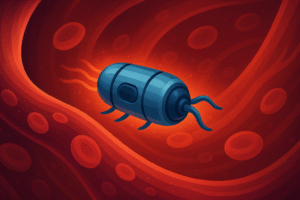Fun Fact: Neutrinos are so small and elusive that billions of them pass through your body every second without you even noticing.
What’s lighter than a feather, invisible to the eye, and zooms through the universe—and through you—every moment of the day? It’s not a sci-fi ghost. It’s the neutrino, one of the strangest and most mysterious particles in the universe.
Thanks to the efforts of scientists working on the Karlsruhe Tritium Neutrino (KATRIN) experiment in Germany, we are now closer than ever to knowing how much these ghost-like particles weigh. In April 2025, researchers announced a major breakthrough: they confirmed that the neutrino has a mass of less than 0.45 electron volts (eV), making it at least one million times lighter than an electron.
Let us explore why this discovery is so significant and how it was achieved.
What Are Neutrinos
Neutrinos are elementary particles that behave in very unusual ways. They are invisible, have no electric charge, and travel close to the speed of light. Most astonishingly, they can pass through planets, buildings, and even people without any effect.
Neutrinos are produced in many places, including the Sun, during nuclear fusion, in supernova explosions, in nuclear reactors, and even in natural radioactive decay processes on Earth. While scientists have learned a lot about where neutrinos come from and how they behave, the exact value of their mass has remained unknown for decades.

Why Neutrino Mass Matters
Understanding the mass of the neutrino is more than just a matter of curiosity. It can help scientists answer some of the biggest questions in physics.
First, it can tell us how neutrinos acquire mass. Most particles get their mass through the Higgs boson, but it is unclear if this applies to neutrinos as well. Second, knowing their mass can help explain why our universe has more matter than antimatter. Third, it may shed light on how galaxies formed in the early universe, since neutrinos were among the first particles to emerge after the Big Bang. Lastly, it could uncover shortcomings in the Standard Model of Particle Physics, which is currently our most reliable framework for understanding the behavior of fundamental particles.
The KATRIN Experiment
To solve the mystery of neutrino mass, scientists launched the Karlsruhe Tritium Neutrino (KATRIN) experiment at the Karlsruhe Institute of Technology in Germany. This is the most advanced experiment ever designed to measure the mass of neutrinos.
KATRIN works by observing a process called beta decay in a radioactive form of hydrogen known as tritium. During beta decay, tritium transforms into helium-3, releasing an electron and an antineutrino. The antineutrino escapes, but the electron remains and carries almost all the leftover energy.
By precisely measuring the energy of these electrons, scientists can estimate the mass of the escaping antineutrino—and by extension, the neutrino itself.
A Giant Spectrometer and Years of Work
At the heart of the KATRIN experiment is a giant 23-meter-long spectrometer. It is a vacuum-sealed device shaped like a blimp that captures electrons and analyzes their energy with incredible precision. Even though the theory behind the experiment is relatively simple, building and operating the spectrometer has been a massive challenge.
Dr. Loredana Gastaldo, a physicist from Heidelberg University, explained that it took years of problem-solving and technical upgrades to get the system to function correctly. They had to manage noise, temperature fluctuations, and maintain an ultra-clean environment.
The New Result: Less Than 0.45 eV
In 2022, KATRIN had already set a record by limiting the neutrinos’ mass to less than 0.8 eV. But with 259 additional days of data collected, scientists have now refined that number further to 0.45 eV.
To put this into perspective, the mass of an electron is about 511,000 eV. This means that the neutrino is confirmed to be more than a million times lighter than an electron.
This result confirms that neutrinos are among the lightest known particles in the universe.
Still Not the Final Answer
Although this is a groundbreaking achievement, the work is far from over. The KATRIN team is still collecting data, aiming for a total of 1,000 days. With that complete dataset, they hope to push the limit even lower to 0.3 eV or possibly even 0.2 eV.
If neutrinos had been closer to 1 eV in mass, KATRIN might have been able to measure the exact value. But since they are even lighter, more advanced tools will be needed in the future.
Physicist Alexey Lokhov, based at the Karlsruhe Institute of Technology, suggests that a new upgrade called KATRIN++ might be the next step to further improve sensitivity.
Why This Matters to Everyone
It may be tempting to think this research only matters to scientists. But it actually has wide-reaching implications.
First, learning about neutrinos helps us understand the universe we live in, including how it began and how it evolved.
Second, the technology developed for experiments like KATRIN often leads to real-world applications in areas like medical imaging, energy research, and advanced computing.
Third, the principles used in neutrino research are related to nuclear fusion, a potential source of clean and limitless energy in the future.
In short, solving the mystery of neutrino mass could help shape the future of science, medicine, and energy.
What Lies Ahead
The journey to measure the neutrino’s mass is not over. Other upcoming experiments, such as Project 8 and the Holmes and ECHo initiatives, are exploring new methods using radio-frequency detection and microcalorimetry. These could provide even more accurate results or uncover entirely new properties of neutrinos.
Scientists are also investigating whether neutrinos are their own antiparticles through a phenomenon known as neutrino-less double beta decay. If proven, it would revolutionize our understanding of matter and antimatter.
Conclusion
Neutrinos are some of the most intriguing particles in the universe. They are tiny, fast, and nearly impossible to detect. But they may hold the key to solving some of the biggest questions in physics and cosmology.
The KATRIN experiment has now confirmed that neutrinos weigh less than 0.45 eV, a huge step forward in particle physics. With more data and improved technology, scientists hope to eventually uncover the exact mass and unlock more secrets of the universe.
This discovery reminds us that even the smallest things can have the biggest impact.
Author’s Note
This blog highlights a remarkable achievement in science by researchers dedicated to uncovering the most elusive details of the universe. While the neutrino is small and difficult to detect, understanding its properties may change how we view the universe forever.
G.C., Ecosociosphere contributor.
References and Further Reading
- Nature News: Physicists narrow down neutrino’s mysterious mass
https://doi.org/10.1038/d41586-025-01157-1 - KATRIN Official Website – Karlsruhe Institute of Technology (KIT)
https://www.katrin.kit.edu




